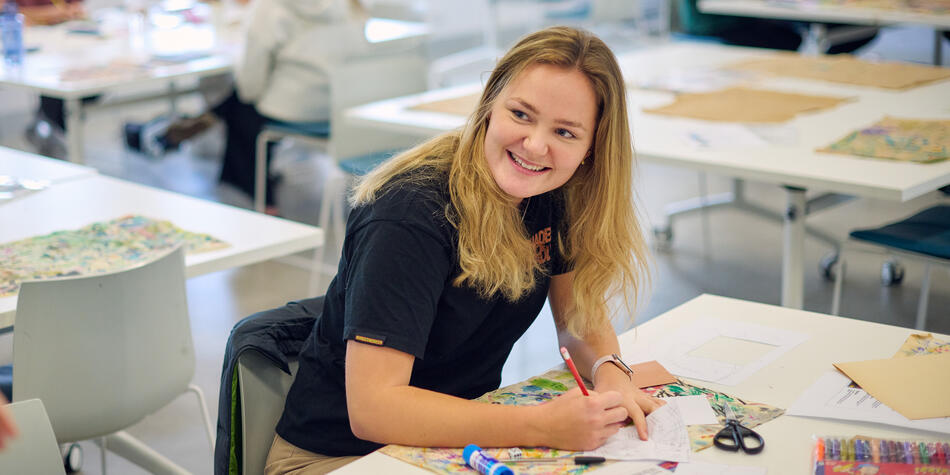At Deakin, teaching placements make up a large part of the curriculum for those studying a teaching degree, and you’ll get started in the classroom right from the beginning. From the first year and all the way through, students build skills by observing and eventually teaching in classrooms across Victoria and interstate – and even overseas as part of Deakin’s Global Education Program.
From year one, undergraduate teaching students are supported through placements focusing on classroom observation. As you progress through your degree, your role in the classroom grows.
By final year, those studying early years and primary teaching, and health and physical education, complete up to three placements in one classroom. This allows you to ‘get to see how the classroom is set up and how the expectations are set up,’ says Professional Experience Coordinator Rebecca Stephenson.
Finding a teaching placement
Thanks to Deakin’s Professional Experience Office, we’re one of the few universities that ensures 100% of students are placed, and our teaching graduates have one of the highest rates of employment. All the staff in the Professional Experience Office have worked in teaching themselves, which helps with accessing appropriate placements for each student, and providing the support they need.
‘It’s so easy; they do it all for us,’ says Caitlin Potter, a final year student studying early childhood education and primary teaching. ‘For a few years I didn’t have a car, and the Professional Experience Office would call and check that the placement they chose for me wasn’t too difficult to get to.’
Students can get assistance to complete placements not just in Melbourne, but from across Victoria and even out of state or overseas.
Essential to learning from the first year
Getting an early start in the classroom from the first year of their teaching degree is of huge benefit to students. ‘It’s so important to have [teaching placements] early on. It really helps with learning about the development and settings,’ Caitlin says. ‘It gives you more insight than any book or course will ever give you.’
Adela Hogan, a primary education student, agrees. ‘It’s incredible,’ she said during her lunch break, as she directed her class in the background. ‘I love being in the classroom.’
Expectations and reality
Going into primary school classrooms, Caitlin was nervous at the thought of teaching maths and science, worried that she wouldn’t be fully prepared or informed. But the reality was completely different. ‘I was so pleasantly surprised. It was such a relief to know you don’t need to know everything. The people around you are there to support you and teach you,’ she reflects.
Adela had a similar experience: ‘I had fears about expectations of content knowledge, thinking I had to already know what I needed to teach, what the students should know and how to teach it all. That was so untrue, we look at the curriculum weekly and decide which areas we’ll teach for the upcoming week and plan altogether in year-level groups.’
Highlights of teaching placement
Despite the hard work and long hours, the classroom teaching experience is extremely rewarding, and will prepare you for your future career.
‘When children learn something, it is such a sense of achievement and pride. When you’re leaving placement you realise what an impact you have had on them and what an impact they have had on you,’ Caitlin says. ‘I was so anxious about going into year 6 classrooms, and then finishing up, it was so special to see the connections at the end. When you leave, you feel a sense of belonging. That’s a good sign that teaching is the right path for you.’
For Adela, she knew she wanted to be a teacher when she taught her first class. ‘It’s different when you observe. When you start teaching and you see the kids learn, it’s amazing,’ she said, ‘I love watching the students get excited when you’re teaching a lesson, reading a book or playing a maths game. Although the best part is watching them struggle with a concept, talk through it and see them totally grasp the concept. It’s so rewarding to see you bringing clarity to a student, helping them grow.’
Advice for your teaching placements
‘The more you give, the more you get out of it,’ says Professional Experience Placement Coordinator Rebecca Stephenson. ‘Don’t be afraid to try new things; your skills will really improve.’ She encourages students to complete placements in schools they wouldn’t necessarily work in after graduating. ‘It may not be what you want to do, but it will help you. You should do more than you’re expected to do.’
Stephenson says it’s important during your placements to start preparing yourself for what it means to become a teacher. ‘There’s a lot of behind-the-scenes work. There’s a lot you take home with you. It’s more of a lifestyle than a job. It’s part of an identity; it’s who you are.’
To avoid taking home the stress, it’s importance to find balance. Caitlin advises: ‘talk to mentors and other teachers and ask their advice if you’re struggling.’
Don’t shy away from bringing your own teaching style to the classroom during placement, suggests Adela. ‘Listen to everything that teachers tell you, but stick to your style.’
And even when it gets hard, ‘stick with it,’ Adela urges. ‘Even if you don’t end up teaching, there’s so many things you can do.’

